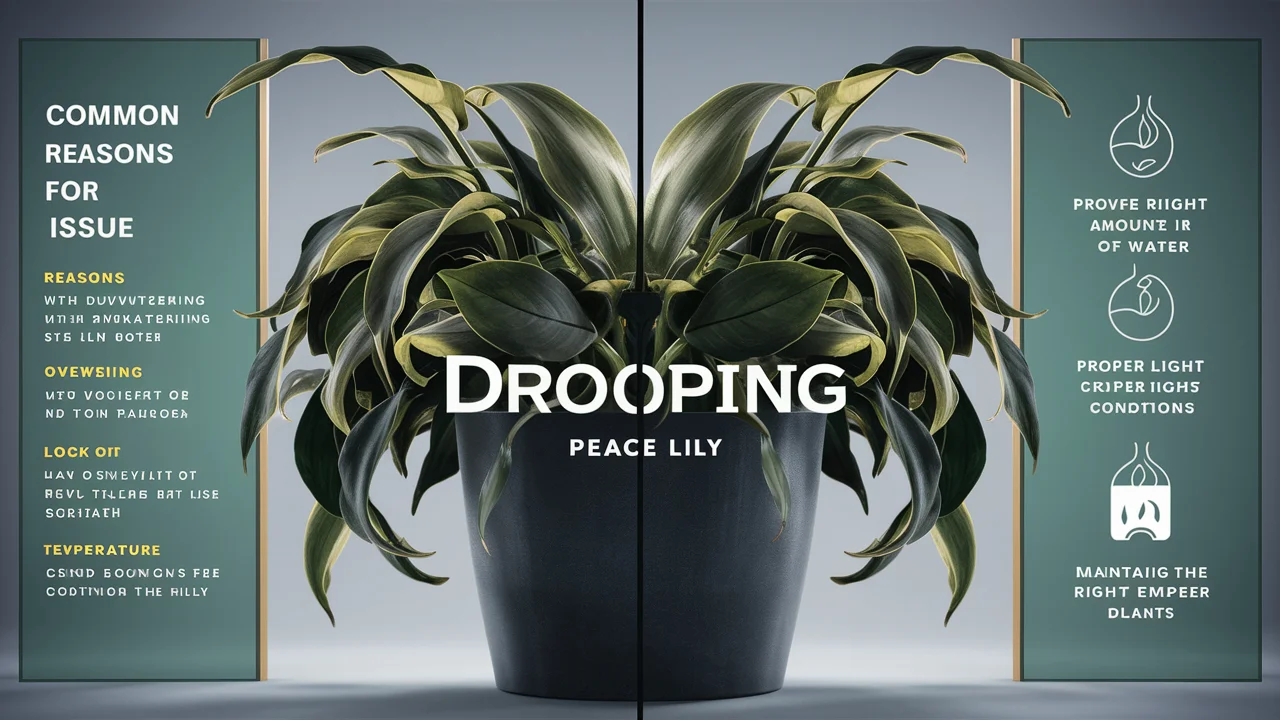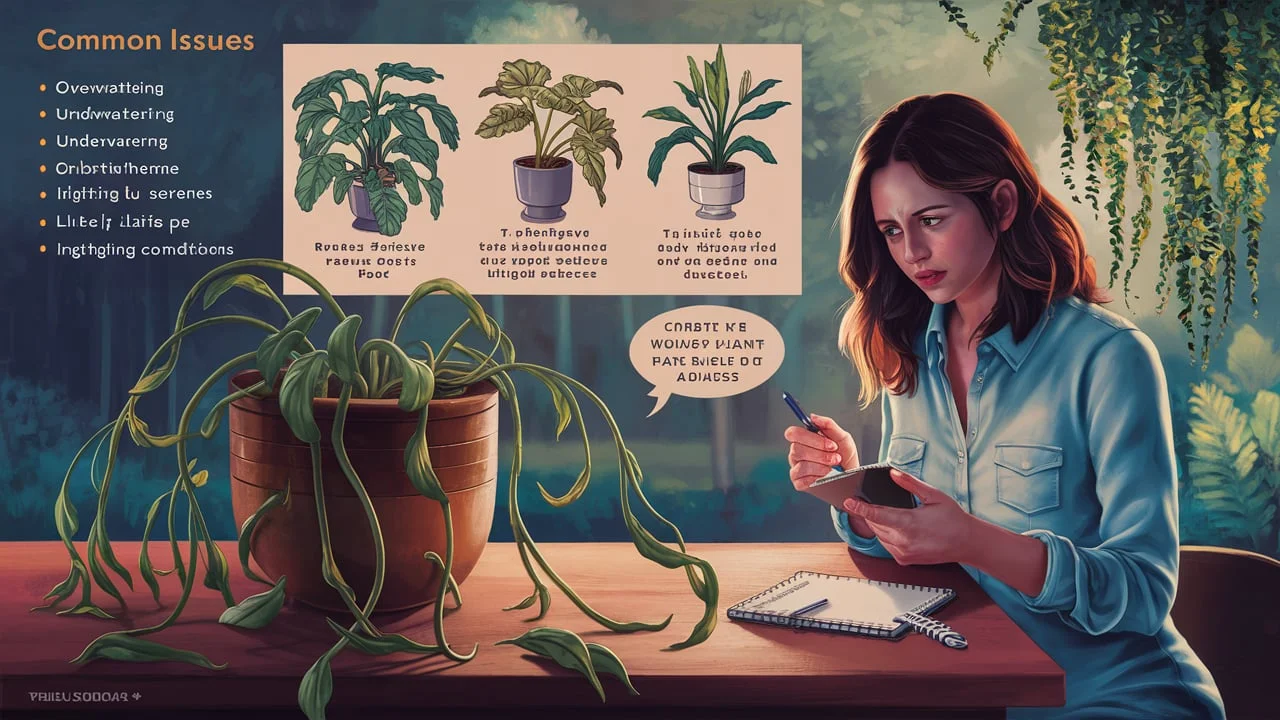Peace lilies (Spathiphyllum spp.) are favored indoor plants known for their striking white flowers and rich green foliage. Nonetheless, many individuals who grow peace lilies have a tendency to ask themselves, “Why is my peace lily drooping?” Herein lies a comprehensive guide that will assist you in understanding why your leaves are drooping and offer effective remedies to revive the plant.
Reasons for Drooping Leaves in Peace Lilies

Drooping leaves in peace lilies can signal a range of issues, from simple watering mishaps to environmental stressors. Here are the main reasons for drooping leaves in peace lilies and how to resolve them:
1. Underwatering
– Cause: Peace lilies need consistent moisture, and underwatering is the most common reason for drooping leaves. When the soil dries out too much, the plant can’t absorb water efficiently.
– Solution: Water the plant thoroughly, allowing excess water to drain out. Check the soil regularly and water once the top inch feels dry.
2. Overwatering
– Cause: Excess water can suffocate the roots, causing root rot, which leads to drooping. Peace lilies prefer slightly moist soil, not waterlogged conditions.
– Solution: Allow the soil to dry out a bit between waterings. Make sure your pot has drainage holes and avoid leaving the plant sitting in standing water.
3. Low Humidity
– Cause: Peace lilies are native to tropical regions and need higher humidity to thrive. Dry indoor air can cause their leaves to droop.
– Solution: Increase humidity by misting the plant, placing it on a pebble tray, or using a humidifier nearby, especially in winter.
4. Inadequate Light
– Cause: Peace lilies do best in low to moderate indirect light. Too much direct sunlight can scorch the leaves, causing them to wilt, while too little light can hinder healthy growth.
– Solution: Place the plant in bright, indirect light. Avoid placing it in direct sunlight, which can lead to leaf drooping and browning.
5. Temperature Stress
– Cause: Peace lilies are sensitive to temperature changes. Cold drafts or extreme heat can shock the plant, leading to drooping.
– Solution: Keep the plant in a stable environment with temperatures between 65–80°F (18–27°C). Avoid placing it near heaters, air conditioners, or drafty windows.
6. Nutrient Deficiency
– Cause: Peace lilies need essential nutrients to grow well, and a lack of nutrients can weaken the plant, causing drooping leaves.
– Solution: Feed your peace lily with a balanced, water-soluble fertilizer every 6–8 weeks during the growing season. Avoid over-fertilizing, as it can damage the roots.
7. Root Bound
– Cause: If your peace lily has outgrown its pot, the roots can become cramped, making it difficult for them to absorb water and nutrients effectively.
– Solution: Repot the plant in a slightly larger container with fresh soil, allowing the roots more space to grow and absorb moisture.
8. Pests and Diseases
– Cause: Common pests like spider mites and mealybugs can sap the plant’s nutrients, causing leaves to droop. Additionally, root rot or fungal infections can weaken the plant.
– Solution: Regularly inspect the plant for pests and treat with insecticidal soap if needed. For diseases, prune affected roots and repot with fresh soil if root rot is present.
Addressing the specific needs of your peace lily will help prevent drooping leaves, ensuring it remains vibrant and healthy!
Peace Lilies Growth Cycle Explained
Here’s a detailed explanation of the growth cycle of peace lilies, including the importance of dormant periods, environmental adjustments, and preventive care to ensure they thrive:

Peace lilies (Spathiphyllum) have a unique growth cycle that includes active and dormant phases. Understanding these cycles helps maintain the health and vitality of your plant, preventing common issues like drooping leaves and growth stagnation.
1. Dormant Periods
Peace lilies enter a dormant period, usually during the winter, when their growth naturally slows down. This is normal and doesn’t necessarily indicate a problem.
– Natural Drooping: Some drooping may occur as the plant conserves energy.
– Solution: Reduce the watering frequency slightly during dormancy but ensure the soil stays lightly moist. Maintain bright, indirect light and consistent humidity to support the plant during this resting phase.
2. Environmental Adjustments
Peace lilies are sensitive to their surroundings, and sudden environmental changes can stress them, causing drooping or stunted growth.
– Solution: When moving your peace lily to a new location, make gradual adjustments. Avoid exposing it to sudden changes in temperature or light. Place it in a stable, bright spot with indirect sunlight.
—
Preventive Measures for Healthy Growth
Following a regular care routine will help your peace lily stay healthy and prevent issues like drooping leaves. Here’s a breakdown of essential maintenance steps:
1. Regular Care Routine
Stick to a consistent care schedule, including watering, humidity control, and monitoring the plant’s condition.
– Normal Watering: Keep the soil evenly moist but avoid waterlogging. Water when the top inch of soil feels dry.
– Humidity Maintenance: Ensure adequate humidity around your plant, especially if indoor air is dry. Misting, a pebble tray, or a humidifier can help.
– Temperature Stability: Maintain a consistent room temperature between 65–80°F (18–27°C) and avoid exposing the plant to drafts or extreme temperatures.
– Even Fertilization: Use a balanced, water-soluble fertilizer during active growth periods (spring and summer) every 6–8 weeks, but avoid over-fertilizing during the dormant phase.
2. Proper Repotting Frequency
Peace lilies need enough room to grow and should be repotted every 1–2 years, or when the roots become crowded. Proper spacing allows the roots to expand and improves nutrient and water absorption.
– Roots Inspection: When repotting, inspect the roots. Healthy roots should be white and firm. If you find any black, mushy, or rotting roots, trim them away to promote healthy growth. Rinse the healthy roots with water, and repot the plant in fresh, well-draining soil.
Monitoring Plant Health: Early Detection
Regularly check your peace lily for early signs of distress, so you can address issues before they worsen.
1. Leaf Quality
Observe the leaves for any brown spots, yellowing, or drooping. These may indicate watering issues, nutrient deficiencies, or environmental stress.
2. Soil Moisture Content
The soil should remain lightly moist. Avoid letting it dry out completely or become too wet. Check the soil moisture by touching the top inch with your fingers.
3. Root Health During Repotting
Each time you repot, check the roots. Healthy roots should be white and firm. Brown or black roots are a sign of rot and should be trimmed. Repotting gives the plant a refreshed environment, helping it regenerate and grow more vigorously.
By following these steps and maintaining a balanced care routine, your peace lily can thrive throughout its growth cycles, displaying lush, healthy foliage and vibrant blooms.
Conclusion
Having an understanding of why peace lily’s leaves droop and how this problem can be resolved will enable you maintain a healthy thriving plant. Your peace lily will grow lush upright foliage and beautiful flowers by adjusting watering habits increasing humidity providing appropriate nutrients and repotting when required. This way your peace lily’s leaves will increase in size become more erect with time hence improving its appearance. Furthermore constant care coupled with regular check ups will ensure that peace lily remains in good shape for many years.
Frequently Asked Questions
1. Why are my peace lily leaves drooping even though I water it regularly?
Answer: Overwatering is a common reason for drooping leaves in peace lilies. Although they like moisture, too much water can lead to root rot, which causes drooping. Make sure the soil drains well and let it dry slightly between waterings.
2. Could dry indoor air cause my peace lily’s leaves to droop?
Answer: Yes, peace lilies prefer higher humidity, and dry air can lead to drooping leaves. If your indoor environment is dry, especially in winter, use a humidifier or mist the plant to maintain moisture levels around it.
3. Do peace lilies need more light to prevent drooping?
Answer: Peace lilies do well in bright, indirect light. Too much direct sunlight can cause drooping and scorched leaves. Place it in a well-lit area without direct sunlight, like near a north or east-facing window.
4. Could temperature changes be making my peace lily droop?
Answer: Yes, sudden temperature changes can stress the plant, causing drooping. Peace lilies prefer stable temperatures between 65–80°F (18–27°C). Keep them away from drafts, air conditioners, and heaters to prevent drooping from temperature stress.
5. How does the pot size affect my peace lily’s health and drooping leaves?
Answer: Peace lilies can become root-bound, meaning their roots have outgrown the pot, which limits water and nutrient absorption, causing drooping. Repotting every 1–2 years in a slightly larger pot helps prevent this and supports healthy growth.





